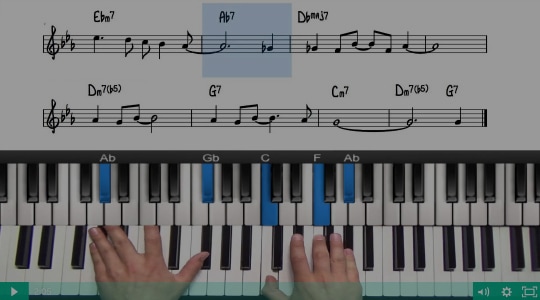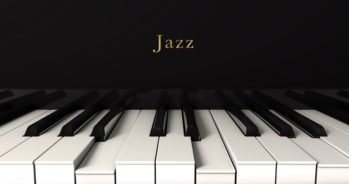When I pick up a lead sheet or jazz standard, all I am given is the melody note and the chord symbol. Almost subconsciously, my fingers will create suitable ‘jazz voicings’ containing extensions and also alterations if necessary.
I have developed the ability to do this purely from playing lots of jazz standards and being exposed to ‘a similar situation’ before. For example, if I come across a minor chord with the 9th in the melody, I know lots of different minor chord voicings that have the 9th on top so my hands instinctively gravitate towards these voicings.
Every time I come across a chord on a lead sheet, I analyse the scale degree of the melody in relation to the chord underneath. I have got to a point where i do not need to think about this, my hands just go for the voicing but as a beginner, you should always make a conscious analysis of this when you are playing through jazz standards and it will help you memorise and internalise voicings.
By ‘internalise’ I mean remember the formula. With jazz it is far more efficient to think in terms of numbers (or scale degrees) than to think of individual notes.
For example, with the Herbie Hancock Chord Voicing – the formula is – left hand: Root and 5th – right hand: b3, 11, b7 and 9.
Knowing this formula means I can find this voicing in any key, provided that I know the 12 major and minor scales. That’s why is important to know your scales!!
When you are practising scales, learn the scale degrees as numbers, for example in C Major – C(1) D(2) E(3) F(4) G(5) A(6) B(7). Do this for all keys and you can also practice it away from the piano by asking yourself, “what’s the 5th of Ab Major” or “what’s the 3rd of F Minor” etc…
From thinking in terms of numbers instead of actual notes, you get a functional understanding. For example, if I play the 9th in the melody over a major or minor chord, I know it will sound ’sweet and colourful’ – no mater what key I am in.
In the same way, if you wanted to create a 251 in the key of Gb Major, you need to build a minor chord off the 2nd degree (Ab), a dominant chord off the 5th degree (Db) and a major chord off the 1st Degree (Gb).
To summarise, looking at keys ‘numerically’ saves a lot of time and gives you greater freedom on the keyboard. Also when you come to try improvisation, having a numeric understanding of the keys is vitally important.
Learning jazz piano is very different to learning classical piano. One of the reasons it’s so difficult is that you are making the transition from reading notes from a page, to spontaneously creating music using limited information from a lead sheet.
Always thinking numerically will help you greatly as you progress and develop as a jazz musician.



Leave a reply